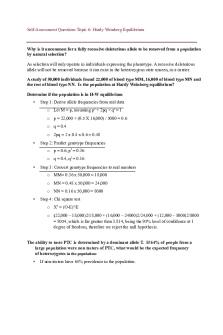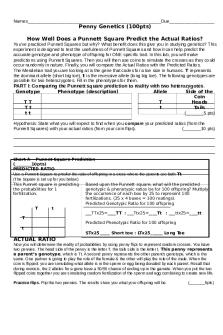Genetics Tutorial PDF

| Title | Genetics Tutorial |
|---|---|
| Course | Animal Genetics |
| Institution | Charles Sturt University |
| Pages | 5 |
| File Size | 197.5 KB |
| File Type | |
| Total Downloads | 1 |
| Total Views | 151 |
Summary
Genetics Tutorial...
Description
Self-Assessment Questions Topic 6: Hardy Weinberg Equilibrium
Why is it uncommon for a fully recessive deleterious allele to be removed from a population by natural selection? As selection will only operate in individuals expressing the phenotype. A recessive deleterious allele will not be removed because it can exist in the heterozygous state unseen, as a carrier. A study of 50,000 individuals found 22,000 of blood type MM, 16,000 of blood type MN and the rest of blood type NN. Is the population at Hardy Weinberg equilibrium? Determine if the population is in H-W equilibrium
Step 1: Derive allele frequencies from real data o Let M = p, assuming p2 + 2pq + q2 = 1 o p = 22,000 + (0.5 X 16,000) / 5000 = 0.6 o q = 0.4 o 2pq = 2 x 0.4 x 0.6 = 0.48
Step 2: Predict genotype frequencies o p = 0.6, p2 = 0.36 o q = 0.4, q2 = 0.16
Step 3: Convert genotype frequencies to real numbers o MM= 0.36 x 50,000 = 18,000 o MN = 0.48 x 50,000 = 24,000 o NN = 0.16 x 50,000 = 8000
Step 4: Chi square test o X2 = (O-E)2/E o (22,000 – 18,000)2/18,000 + (16,000 – 24000)2/24,000 + (12,000 – 8000)2/8000 = 8054, which is far greater than 3.814, being the 95% level of confidence at 1 degree of freedom, therefore we reject the null hypothesis.
The ability to taste PTC is determined by a dominant allele T. If 64% of people from a large population were non tasters of PTC, what would be the expected frequency of heterozygotes in the population:
If non-tasters have 64% prevalence in the population:
F(tt) = q2= 0.64
Q = square root of 0.64 = 0.8
P = 1-q = 1-0.8 = 0.2
2 pq = f(Tt) = 2 x 0.8 x 0.2 = 0.32 = 32%
Rate of evolution will occur faster in:
a larger population compared to a smaller population, as the chance of mutations occurring is larger, therefore increasing rate of evolution
A progressively colder population – evolution
Populations that are exposed to each other rather than isolated population
An ecosystem without the ozone layer – selection pressure
The incidence of a red/ green colour-blindness in males caused by a recessive sex-linked allele is approximately 10% in males. What is frequency of the defective allele in the population? Frequency = 0.1. It is the frequency of males with the trait since they only have one allele Red tail colour in a bird population is governed by a single autosomal gene, with the allele for red (R) being completely dominant and the plain tail (P) being recessive. a.
b.
If f(R) = 0.2, what proportions of each phenotype would you expect to see? p= 0.2, p2 = 0.04 q= 0.8, q2 = 0.64 2pq = 0.32 What would you expect to see if you knew that: Birds will choose to mate with birds of their own tail colour. An increase in number of red tail colour
c.
Birds with red tails are more easily caught by predators. An increase in plain tail colour as the red allele will be removed from the population
d.
A nearby population of the same species has f(R) = 0.9 and you suspect some mixing of the populations. An increase in frequency of red tail colour
2
PKU is an autosomal recessive trait in humans which appears phenotypically in one person in every 40 000. A man has a sister with PKU. What is the probability that he has a child with PKU, assuming random selection of his partner from the society? Assume that neither parent nor the man’s conjugal partner exhibit the PKU phenotype.
Need to calculate the parents’ probability of being carriers of the recessive allele p
Probability of the mother being a carrier = frequency of heterozygote individuals within the population (q) o q= 1/40000 = square root = 0.005 o therefore, p = 1-q = 0.995 o 2pq = 2 x 0.995 x 0.005 = 0.00995
3
Probability that mother is a carrier is 2/3
Probability of producing offspring with the pp allele from the two carrier parents Pp x Pp =¼
Probability of child having the pp genotype = ¼ x 2/3 x 0.00995 = 1/600 = 0.0017
There is a genetic test available for particular mutant alleles of the thyroglobulin gene in beef cattle which reportedly is associated with marbling. The test called ‘GENESTAR’ was used by an Angus breeder on 118 of his male calves picked at random from his herd. The test results are given as stars so that a single favourable allele (heterozygote) is given a single star and homozygotes for the favourable allele is given two stars. An animal lacking the favourable allele has zero stars. The results were as follows:
Genotype Number of Calves **
10
*
33
--
75
What is the frequency of the favourable marbling allele in the herd? F(*) = 2 x 10 + 33 /118 x 2 = 0.225 F(-) = 1-0.225 = 0.775 If the breeder mates his cows with ** bull only predict the test results for 100 animals in the next generation. (*) = 0.225 x 100 = 22, therefore 22 cows will have the allele ** in the F1 generation (as we are crossing together) (-) = 0.775 x 100 = 78, therefore 78 cows will have the allele *- in the F1 generation after the first cross. There will be no unfavorable alleles in the population
In this next generation what is the frequency of the favourable marbling allele and how many times is its frequency increased over the previous generation?
4
F(*) = 22 x 2 + 78 / 100 + 2 = 0.61 Tripled the allele frequency by 60%, demonstrating the influence said allele has on the population
5...
Similar Free PDFs

Genetics Tutorial
- 5 Pages

Genetics and Genomics Tutorial Notes
- 12 Pages

Genetics Penny Genetics
- 4 Pages

Genetics questionse
- 10 Pages

2.3,5 - Genetics
- 13 Pages

Genetics objectives
- 26 Pages

Mouse Genetics
- 5 Pages

Human Genetics
- 500 Pages

Penny genetics
- 3 Pages

Genetics Notes
- 3 Pages

Genetics -midterm
- 2 Pages

Quiz - Genetics
- 2 Pages

Population Genetics
- 6 Pages

Genetics Vocab
- 5 Pages
Popular Institutions
- Tinajero National High School - Annex
- Politeknik Caltex Riau
- Yokohama City University
- SGT University
- University of Al-Qadisiyah
- Divine Word College of Vigan
- Techniek College Rotterdam
- Universidade de Santiago
- Universiti Teknologi MARA Cawangan Johor Kampus Pasir Gudang
- Poltekkes Kemenkes Yogyakarta
- Baguio City National High School
- Colegio san marcos
- preparatoria uno
- Centro de Bachillerato Tecnológico Industrial y de Servicios No. 107
- Dalian Maritime University
- Quang Trung Secondary School
- Colegio Tecnológico en Informática
- Corporación Regional de Educación Superior
- Grupo CEDVA
- Dar Al Uloom University
- Centro de Estudios Preuniversitarios de la Universidad Nacional de Ingeniería
- 上智大学
- Aakash International School, Nuna Majara
- San Felipe Neri Catholic School
- Kang Chiao International School - New Taipei City
- Misamis Occidental National High School
- Institución Educativa Escuela Normal Juan Ladrilleros
- Kolehiyo ng Pantukan
- Batanes State College
- Instituto Continental
- Sekolah Menengah Kejuruan Kesehatan Kaltara (Tarakan)
- Colegio de La Inmaculada Concepcion - Cebu

